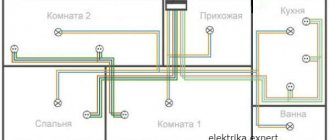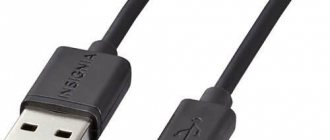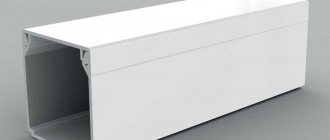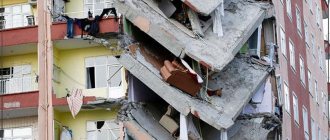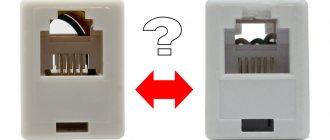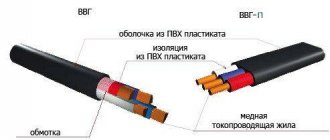Home » Electrical wiring » Electrical wiring installation » Wiring in hazardous areas
Wiring in explosive areas must be carried out using a special cable, as well as in strict compliance with all norms and requirements of GOST, SNiP, and PUE. Thanks to this, you will be able to secure your premises in the future.
In this article, we tried to tell you how cables are laid in hazardous areas and what requirements must be met for installation.
Cable entries and plugs (parts)
The cable gland is used to insert cables into the housing of the box in such a way that the appropriate type of explosion protection is ensured. The cable gland also protects the cable from being accidentally pulled out. The cable is secured in the cable entry using an O-ring or sealing compound.
Cable entries are of the following types:
- for unarmored cable (without armor fastening device);
- for armored cable with a single seal (with armor fastening and sealing on the inner sheath of the cable);
- for armored cable with double seal (with armor fastening and sealing on the inner and outer sheath of the cable);
- with fastening of a metal hose that protects the cable from chemical and mechanical damage, exposure to moisture and solar radiation.
Spring terminal mounted on DIN rail. Side view
It should be noted that the cable entry for unarmored cable can also be used for entry of armored cable.
In this case, the seal should be made along the inner sheath of the cable, and it is also necessary to provide for grounding of the cable armor.
A cable gland with a metal hose fastening consists of a cable gland with an internal thread at the end and a connector, which is mounted on the metal hose on one side and screwed into the cable gland on the other, thereby ensuring reliable fastening of the metal hose. There are connectors for non-hermetic and sealed metal hoses. The sealed metal hose has a PVC sheath on the outside (for example, metal hose GERDA-MG according to TU 4833-011-76960731–2008 manufactured by Donkabel LLC, Proletarsk, Russia).
Cable glands are made from the following materials:
- nickel-plated brass (the most preferred option);
- brass (corrosion is possible in aggressive environments, as well as when installed on an aluminum alloy box);
- plastics (cheaper, but not designed for low operating temperatures);
- of stainless steel;
- galvanized steel.
On the housing, the cable entry must have an explosion protection marking corresponding to the explosion protection marking of the box on which it is installed. A seal (gasket) must be installed between the cable entry and the box body.
Cable entry (a) and hole plug (b)
The opening of an unused cable entry must be closed with a plug having the appropriate type of explosion protection and degree of protection against external influences IP.
What to look for when choosing a box
When choosing an explosion-proof junction box, it is recommended to control:
- availability of a valid GOST R certificate of conformity for compliance of the boxes with the standards of explosion-proof equipment (GOST R 51330–99. Explosion-proof electrical equipment). The certificate must list all third-party components used (for example, terminals and cable glands);
- availability of permission from Rostekhnadzor for use in explosive areas;
- compliance of the operating temperature range of the components with the temperature range of the box body. Often the box body is designed for a lower operating temperature than the terminals and cable entries. In this case, the application temperature is determined by a narrower range;
- presence and compliance of explosion protection markings on the connection box, terminal clamps and cable entries;
- in metal boxes - the presence of an internal and external grounding clamp;
- the maximum surface temperature should not exceed the auto-ignition temperature of the mixture present in the atmosphere of the explosive zone.
To do this, for example, the permitted currents flowing through the terminal clamps must not be exceeded so as not to exceed the value of the maximum power dissipation of the box;
- on the degree of protection from external influences (IP code). Modern boxes have a code of at least IP66;
- It is desirable that the cable entry be fastened along a thread cut in the box body. The thread types of imported cable glands do not match those of Russian ones, so special taps are required to cut threads in the box. Some Russian box manufacturers, not having this tool, install imported cable entries into an unthreaded hole and secure it with a nut, thereby violating the degree of protection from external influences (IP code);
- An important criterion for choosing a box should also be how convenient it is to install wires inside the box. Some manufacturers of junction boxes do not have enough space inside the boxes, which is due to the large size of the terminal clamps with the small geometric shape of the box body.
Systems based on explosion-proof heating cables allow you to effectively solve heating problems
- Easy to install and operate. The heating system does not require special structures and equipment; to protect individual areas (reservoirs, pumping stations, treatment plants, impulse lines) from freezing, local cable heating is most convenient. Control is carried out automatically using automation cabinets. Installation time ranges from several days to a week. Pipelines are most often heated only with a heating cable or a system based on the SKIN effect.
- Economical. Firstly, the installation of heating does not require additional costs for the construction of auxiliary structures, and secondly, the control allows the system to be used only to maintain the required temperature parameters, without unnecessary consumption of thermal energy.
- Reliability. A properly designed and installed cable heating system will last more than 10 years and does not require special maintenance.
Selection of explosion-proof cable
- Let's calculate the required power
- We will select the cable and fasteners suitable for your facility
- We recommend a convenient control system
Thank you, our manager will contact you shortly
Fill in required fields
Calculations will be sent to your e-mail, please check the data carefully when sending.
What types of pipes are best to use?
Various types of pipes can be used for laying wires:
- round suture or seamless,
- profile rectangular or square,
- galvanized (with a cross section of any shape),
- plastic (polyethylene, HDPE).
For most cases, the best option would be to use a galvanized steel profile pipe. Due to its geometry, it provides the best protection against unintentional squeezing or bending of the line, and the zinc layer improves corrosion resistance when used in aggressive environments. At the same time, the absence of a seam does not in any way affect the performance characteristics, but increases the price.
The only situation where steel is inferior to plastic is when laying wires and cables in pipes underground, since polyethylene is much more resistant to direct contact with soil and water. However, it will not save you from mechanical damage - even a blow with an ordinary shovel when digging a line or carrying out other work can damage not only the protection, but also the cable system itself. In this situation, it is necessary to assess the likelihood of damage and select the most reliable product yourself.
Basic cable requirements
At the moment, an explosive facility requires the use of a special cable during wiring. The danger zone can have a variety of classes, but the conductor must have a certain sheath:
- Paper and rubber insulation.
- Polyvinyl chloride and rubber insulation.
- Rubber and lead sheath.
It is important to know! The use of polyethylene-insulated wiring is prohibited at explosive sites.
Class B1 and B1a zones are considered hazardous and therefore the cable line must have copper conductors. To lay a network in zones B16, B1g, B11 and B1a, you can use a cable with aluminum conductors and aluminum insulation. The use of non-insulated conductors in such areas is strictly prohibited. In the photo below you can see the classification of such objects.
Suitable brands of cables and wires that are suitable for hazardous areas include:
- VBBShv.
- KVBbShv.
- VBV.
- CPGN.
- ABBB.
These are the most popular wires and cables that can be used in hazardous areas.
Methods for laying a cable line
How to lay cables in explosive areas? There are several options for laying and these options are recommended by the PUE. For example, in electrical networks with voltages up to 1 kV, a special fourth wire of the conductor is used for grounding or grounding.
At explosive objects in which the danger zone belongs to classes B1 and B1a, the cable line is laid in pipes, which, in turn, are located in the wall. The end of the pipe is processed and sealed with special pipe seals.
Installation of electrical wiring in the place where an explosive object passes into a normal room is carried out as follows: pipe seals are installed on the side of the room where the explosion hazard zone has a high class. If the installation is carried out between rooms where the explosive class is the same, then the pipe seals must be placed in the building where mixtures of a higher category are located. If the hazard class is B1, then the seals should be placed on both sides of the passage.
In order to protect the cable from various mechanical or chemical damage, it is placed in metal pipes. In the pipe, the cable line is under reliable protection. With the help of cast iron boxes, type B (so-called fittings), which are sufficiently protected from explosions, cable lines are connected and branched. The photo below shows the appearance of the explosion-proof box:
If the installation is carried out in a room with high dampness, then the cable is laid with a certain slope towards the broaching and junction boxes. If the area where it is necessary to lay the cable is excessively damp, then the wiring is laid in the direction of the drainage pipe. If the room is dry, then this installation method is not needed, but if condensation is possible, then you should make a slope in the direction where it is expected to fall out.
A dangerous zone implies a different class of object, which determines the method by which the cable can be laid. If the circuit is intrinsically safe, then the installation can be carried out both open and closed. If the explosive object belongs to class B2, then laying is carried out using special trays. In addition, it should be remembered that if the wiring is armored, then it is necessary to use structures with narrow horizontal surfaces. They are also placed on edge and the distance to the wall should be 20 millimeters.
The cable must be laid in an explosive atmosphere so that the wiring is not damaged. In addition, it is necessary that the cable lines themselves are sealed and well protected from explosions, because conductors can be sources of ignition of flammable substances. The area where flammable substances are located is considered explosive and one spark is enough to start a fire. That is why existing safety rules and requirements should be strictly observed and adhered to. If all requirements are met and the rules are followed, then the occurrence of an emergency is minimized.
Cable Requirements
An explosive facility requires the use of a certain type of cable product. The danger zone can be of different classes, but the conductor must have a certain sheath, namely:
- paper and rubber insulation;
- polyvinyl chloride and rubber insulation (used in water and gas pipelines);
- rubber and lead sheath (also used in water and gas pipelines).
The classification of explosive zones is given in Chapter 7.3 of the PUE. An explosive object, regardless of the hazard class, does not allow the use of wiring with polyethylene insulation.
Class B1 and B1a zones are dangerous, so the cable line is used with copper conductors. To lay the network in zones B16, B1g, B11 and B1a, a cable with aluminum conductors and aluminum insulation is used. The use of bare wires in such areas is strictly prohibited.
Classification of dangerous objects:
As for suitable cable brands for laying in hazardous areas, these include VBBShV, KVBBShV, KPGN, VBV and AVBV.
Classification of hazardous areas
| Zone 0, in which an explosive gas mixture is present continuously or for extended periods of time | Zone 1 in which there is a possibility of the presence of an explosive gas mixture under normal operating conditions | Zone 2, in which the presence of an explosive gas mixture is unlikely under normal operating conditions, and if it occurs, it is rare and exists for a very short time | |
| CENELEC/IEC, EUROPE | Zone 0 | Zone 1 | Zone 2 |
| GOST R 51330.9-99, RUSSIA | Zone 0 | Zone 1 | Zone 2 |
| PUE (2001), RUSSIA | B-I, B-II | B-Ia, B-Ib, B-Ig, B-II |
Based on the type or class of the area with the risk of explosions and the protective requirements prescribed for it, as a rule, the necessary properties, parameters, dimensions and other characteristics of cable products are determined. This approach ensures the highest possible level of continuity of operation and safety of operation of electrical machines, mechanisms and other equipment.
Terminals
Terminal clamps (terminals) are designed for connecting and branching conductors. The terminals are installed inside the box body on a DIN rail and are divided into the following:
- regular feed-through terminals;
- Ground terminals (yellow-green) - they have direct electrical contact with the DIN rail.
The terminal is selected according to the maximum cross-section of the connected conductor. In automation practice, the most convenient for installation are the 2.5 mm2 and 4 mm2 terminals; they can be used to connect conductors with a cross-section from 0.25 mm2 to 2.5(4) mm2, respectively.
According to the method of securing conductors, terminals can be screw and spring. Spring terminals significantly reduce installation time, as they do not require screwing. The terminals in the junction box must be numbered.
Each terminal of an explosion-proof box must be marked with an explosion protection marking. For example, in a box with explosion protection type e, there must be a marking containing “Exe” on the terminal body.
Installation features
During installation, it is important to follow the installation rules:
- It is advisable to minimize the number of pipe turns, since each angle complicates cable pulling.
- At network nodes - turns, branches and places where electrical appliances are connected - distribution and wiring boxes are installed. This will simplify cable pulling after pipeline assembly and maintenance of the electrical network during operation.
- To pull electrical cables, a steel string is used: first, it is pulled through the resulting cable channel, the string is connected to the cable and pulled out from the opposite side. Thus, cables are gradually laid throughout the pipeline and the sections of wires in boxes are connected, forming a single electrical network.
- Plastic bushings are fixed at the ends of the pipes, the purpose of which is to prevent chafing of the cable braid.
- It is better to connect pipes using threaded fittings - special connecting elements, and not by welding. This will simplify installation and further repairs.
- The pipeline is secured using clamps and brackets, the distance between which depends on the internal diameter of the pipes.
| Pipe internal diameter, mm | Distance between fastening elements no more than, m |
| 15-20 | 2,5 |
| 25-32 | 3 |
| 40-80 | 4 |
| 100 | 6 |
- Boxes - distribution and traction - are placed at such a distance to ensure ease of pulling cables and simplify their replacement in the future. This distance depends on the number of turns of the electrical cable.
We recommend that you read: Stainless steel air ducts for ventilation installations
| Number of corners | Distance between boxes no more, m |
| 1 | 50 |
| 2 | 40 |
| 3 | 20 |
- If it is necessary to rotate the cable more than 90 degrees, an additional cable duct will have to be installed at the turning point. Otherwise, when pulling the electric cable, it will be caught in the bend of the pipe and it will not be possible to pull it out.
Examples of using
- A pipe for laying cables in the ground is used in cases where there is a possibility of damage. For example, this could be pulling a cable from a private residential house to a garage or other outbuilding located in the yard.
- Preparation of communications for laying wires and cables for various purposes during residential and non-residential construction, including the construction of wooden houses, dachas or cottages.
- When decorating cafes or bars in one of the above styles, the pipe can be used as an interior element, while having the additional opportunity to modernize the lighting system, install signs or displays.
- During renovations in an apartment, the pipe can be used to organize a place for installing a TV: power cables for equipment, antennas and connecting cords from satellite receivers and other multimedia equipment will be “hidden” in a channel located in the wall.
Options for sealing fire penetrations
Vulcan DP slabs from DKS
Fire-resistant panels Probably the cheapest method in terms of implementation: install mineral slabs in a textured hole, simultaneously treating everything with sealant. Can be used if you plan to rarely add or replace cables. PYROBAG pillows from OBO BETTERMANN
Fire-resistant pillows The shell of the pillows is made of fiberglass, which is not affected by humidity. The installation is quite clean - you just need to “stuff” the pillows tightly. A good option for horizontal penetrations with frequent replacement or wiring of cables. Vertical penetrations require supporting structures to prevent the cushions from falling out under their own weight. There are also gaps between the pillows and, for example, DKS recommends sealing them with sealant to prevent smoke penetration. CFS-BL blocks from Hilti
Foam blocks are actually an analogue of pillows, only they can be mounted without gaps. Cut with a stationery knife. Some manufacturers have round sections. Foam from Hilti
Two-part foam and sealants/mastics Typically used to seal small penetrations or gaps in penetrations from larger “assemblies”. Sealants can be used in conjunction with mineral wool (see manufacturers' recommendations). Penetration from Roxtec
Modular blocks of sealed penetrations When you have a lot of money, you need tightness and all that... This is really cool. There are “similar” solutions to Roxtec - CFS-T from Hilti and NTM from the Russian one. Cuff "OGNEZA-PM-K"
Cuffs They are used mainly for pipes, but here the domestic one “distinguished itself”, which uses them as a cable penetration and even allows the cuffs to be recessed inside the passage hole (when installing a steel pipe), making them almost flush with the structure being protected. EZ-Path from Cablofil
“Drawing boxes” Once upon a time, EZ-Path penetrations from Cablifil (part of the group) were unique on the market, but now similar penetrations “OGNEZA-PM-K” (modular) from “OGNEZA” have appeared, and also with a “killer” price CFS-SL GA from Hilti (round section). This option allows you to report and re-stretch cables quite often. CFS-D from Hilti
Disc Amazing solution. I don’t know how Hilti received the necessary certificate, but at a price of 150 rubles. per disk - this is simply an excellent competitor to pena for single cables.
“Stop Fire” promotes the patented Stop Fire system - it looks interesting and apparently inexpensive
I think it's worth paying attention
Penetrations made of metal products with an area of up to 100 cm2 are not required to be grounded (PUE, clause 1.7.77, clause
6). When using pipes, the regulatory documentation does not stipulate anywhere how far the edges should protrude from the final coating. When using metal pipes, take into account “SP 76.13330.2016 Electrical devices. Updated version of SNiP 3.05.06-85” p
6.3.6.2 Steel pipes used for electrical wiring should not have sharp cutting edges or jagged edges. They must have an internal surface that prevents damage to the wire insulation when they are pulled into the pipe and an anti-corrosion coating on the outer surface. For pipes embedded in building structures, external anti-corrosion coating is not required. Pipes laid in rooms with a chemically active environment, inside and outside, must have an anti-corrosion coating that is resistant to the conditions of this environment. Insulating sleeves should be installed where wires exit steel pipes. Typically, “black” electric-welded pipes are used, which have a seam along the pipe, since they are cheaper than water-gas pipes (VGP may be indicated in the description of the pipe). When running cables in external walls, it is necessary to slope towards the street to avoid moisture seepage. I didn’t find the slope value in the regulatory documentation; I usually indicate the range “5-15 degrees”. For cable penetrations in walls with normalized fire resistance, it is necessary to draw up inspection reports for hidden work (one report is allowed for several pieces - for example, for the floor of a building).
If you want to add something, please comment.
